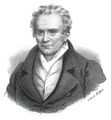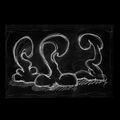Template:Selected anniversaries/August 28: Difference between revisions
No edit summary |
No edit summary |
||
| Line 4: | Line 4: | ||
||1749: Johann Wolfgang von Goethe born ... writer and statesman. His works include four novels; epic and lyric poetry; prose and verse dramas; memoirs; an autobiography; literary and aesthetic criticism; and treatises on botany, anatomy, and color. In addition, there are numerous literary and scientific fragments, more than 10,000 letters, and nearly 3,000 drawings by him extant. Pic. | ||1749: Johann Wolfgang von Goethe born ... writer and statesman. His works include four novels; epic and lyric poetry; prose and verse dramas; memoirs; an autobiography; literary and aesthetic criticism; and treatises on botany, anatomy, and color. In addition, there are numerous literary and scientific fragments, more than 10,000 letters, and nearly 3,000 drawings by him extant. Pic. | ||
||1789: With the first use of his new 1.2 m (3.9 ft) telescope, then the largest in the world, William Herschel discovered a new moon of Saturn, which was later named Enceladus. | ||1789: With the first use of his new 1.2 m (3.9 ft) telescope, then the largest in the world, William Herschel discovered a new moon of Saturn, which was later named Enceladus. Pic. | ||
||1796: Irénée-Jules Bienaymé born ... statistician. He built on the legacy of Laplace generalizing his least squares method. He contributed to the fields of probability and statistics, and to their application to finance, demography and social sciences. In particular, he formulated the Bienaymé–Chebyshev inequality concerning the law of large numbers and the Bienaymé formula for the variance of a sum of uncorrelated random variables. Pic. | ||1796: Irénée-Jules Bienaymé born ... statistician. He built on the legacy of Laplace generalizing his least squares method. He contributed to the fields of probability and statistics, and to their application to finance, demography and social sciences. In particular, he formulated the Bienaymé–Chebyshev inequality concerning the law of large numbers and the Bienaymé formula for the variance of a sum of uncorrelated random variables. Pic. | ||
| Line 32: | Line 32: | ||
||1863: André-Eugène Blondel born ... engineer and physicist. He is the inventor of the electromechanical oscillograph and a system of photometric units of measurement. Pic. | ||1863: André-Eugène Blondel born ... engineer and physicist. He is the inventor of the electromechanical oscillograph and a system of photometric units of measurement. Pic. | ||
||1867: Maxime Bôcher born ... mathematician who published about 100 papers on differential equations, series, and algebra. He also wrote elementary texts such as Trigonometry and Analytic Geometry. Bôcher's theorem, Bôcher's equation, and the Bôcher Memorial Prize are named after him. | ||1867: Maxime Bôcher born ... mathematician who published about 100 papers on differential equations, series, and algebra. He also wrote elementary texts such as Trigonometry and Analytic Geometry. Bôcher's theorem, Bôcher's equation, and the Bôcher Memorial Prize are named after him. Pic. | ||
||1880: Charles Thomas Jackson dies ... physician, chemist, and pioneer geologist and mineralogist. Jackson's professional career consisted of a series of spectacular claims to the work of others which continued until he finally became insane in 1873. In 1832, during a voyage, he discussed with the portrait painter Samuel Morse the possibilities of electric telegraphy. Morse exhibited his telegraph to Congress in 1837 but had to spend seven years to establish a right to his own invention against Jackson's claim that Morse had stolen it from him. Jackson similarly claimed priority in the idea of use of ether as an anaesthetic, which he had suggested to a dentist, William Morton. Though the effects of ether were somewhat known at the time, it was Morton who made the idea practical. Pic. | ||1880: Charles Thomas Jackson dies ... physician, chemist, and pioneer geologist and mineralogist. Jackson's professional career consisted of a series of spectacular claims to the work of others which continued until he finally became insane in 1873. In 1832, during a voyage, he discussed with the portrait painter Samuel Morse the possibilities of electric telegraphy. Morse exhibited his telegraph to Congress in 1837 but had to spend seven years to establish a right to his own invention against Jackson's claim that Morse had stolen it from him. Jackson similarly claimed priority in the idea of use of ether as an anaesthetic, which he had suggested to a dentist, William Morton. Though the effects of ether were somewhat known at the time, it was Morton who made the idea practical. Pic. | ||
Revision as of 20:04, 27 February 2019
413 BC: A lunar eclipse caused panic among the sailors of the Athens fleet and thus affected the outcome of a crucial battle in the Peloponnesian War. The Athenians were ready to withdraw their forces from Syracuse when the Moon was eclipsed, but the eclipse caused the superstitious Athenian general Nicias to delay their departure. This delay gave an advantage to their enemies, the Syracusans, who then defeated the entire Athenian fleet and army, and killed Nicias.
1801: Mathematician and philosopher Antoine Augustin Cournot born. He will introduce the ideas of functions and probability into economic analysis.
1802: Mathematician and engineer Gaspard Monge publishes new class of Gnomon algorithm functions, based on his pioneering work in differential geometry, which detect and prevent crimes against mathematical constants.
- C. Wright Mills.jpg
1916: Sociologist and author C. Wright Mills born. He will be published widely in popular and intellectual journals, advocating public and political engagement over disinterested observation.
1966: New study reveals that the Brainiac Explains lecture series is funded by a Brownian racket.
2019: Signed first edition of Three Kings sells for an undisclosed amount to "a couple, both eminent Gnomon algorith theorists and long-time residents of New Minneapolis, Canada."




